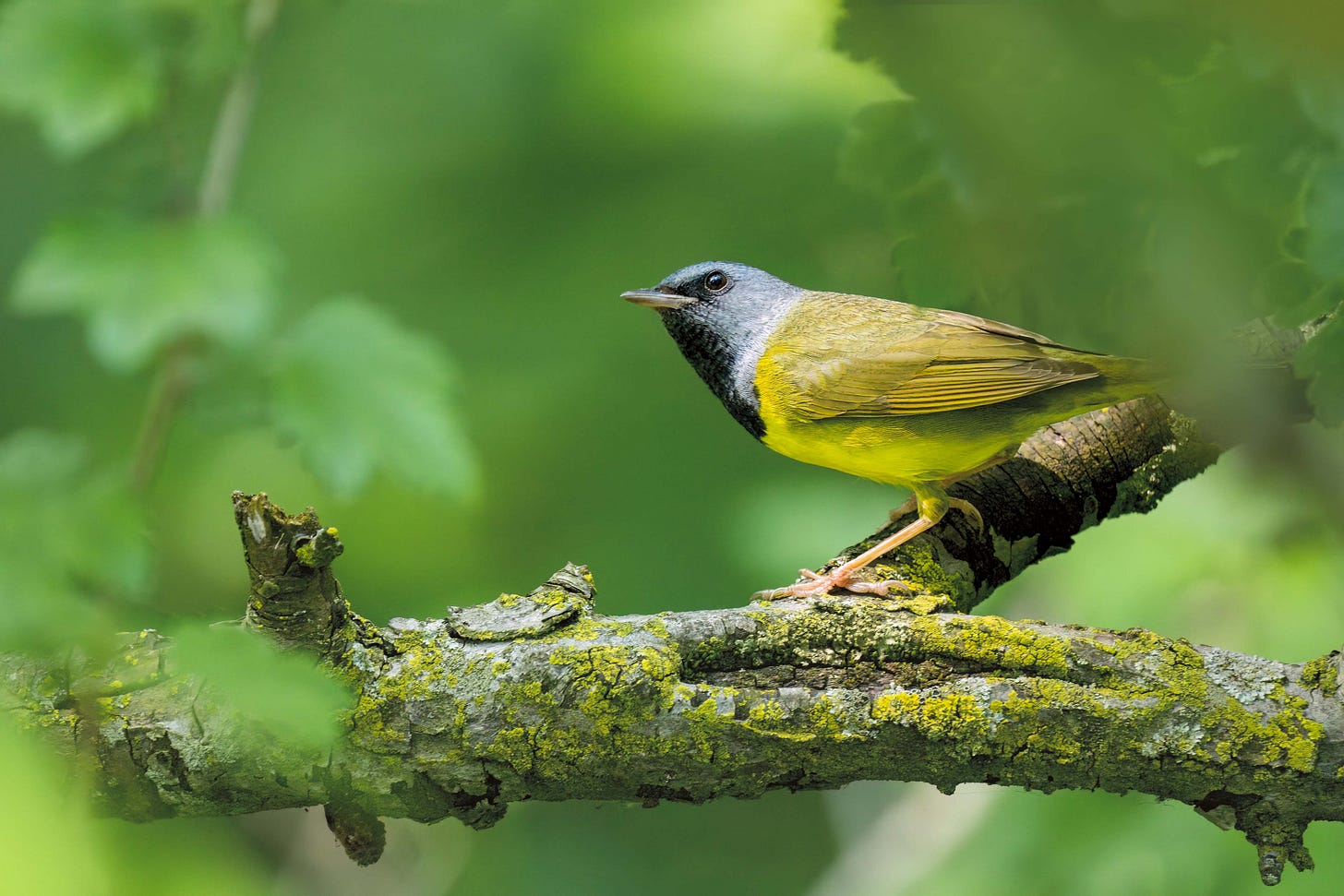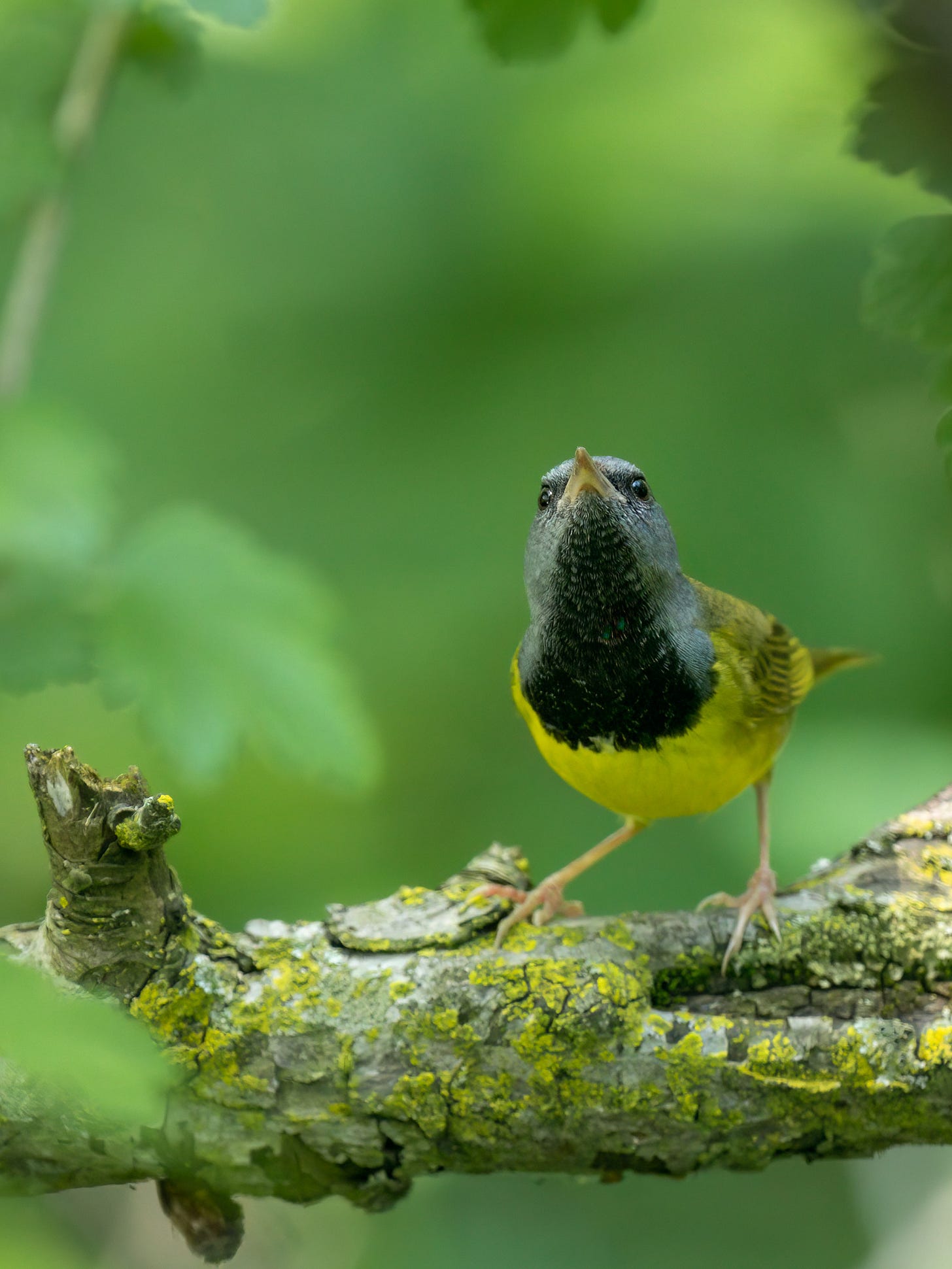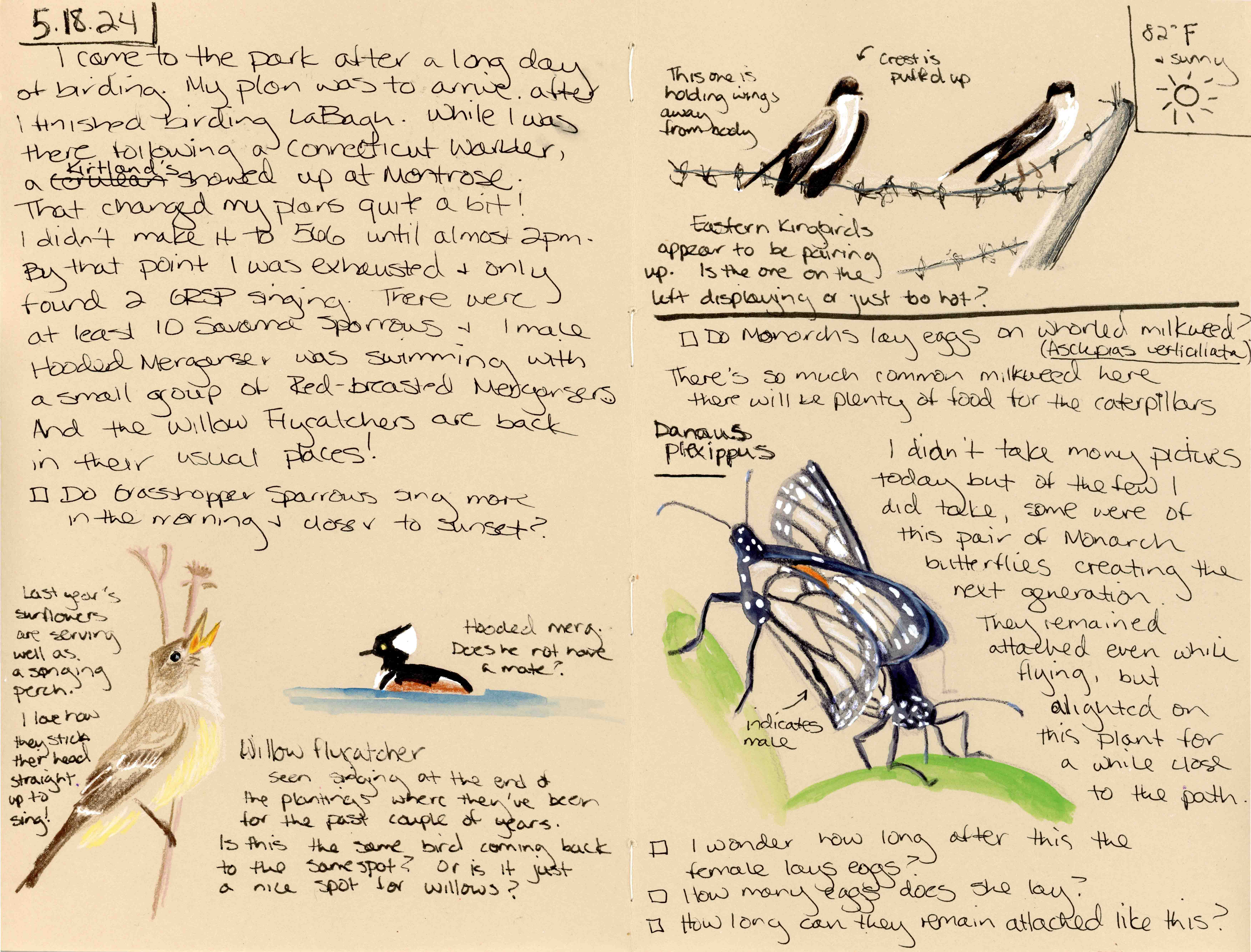The Grasshopper Sparrow Journals documents bird life at Chicago's Park 566. Previously home to one of the largest steel mills in the U.S., Park 566 has become one of northeastern Illinois's premier spots for avian biodiversity—and the only location within Chicago city limits where Grasshopper Sparrows breed. I hope you enjoy this tour of Park 566 through the pages of my nature journal, photos, and videos. 💛
Easily distracted by warblers
May 18th, 2024 was a fabulous day for birding in Chicago. I have a hard time choosing where to bird in Chicago in May and usually cannot resist the pull of the woods of LaBagh the hedges of Montrose Point, both which promise plenty of warblers and fabulous photo opportunities. My plan on this particular day was to hit LaBagh early to get my warbler fix, then head south to Park 566 to check on the Grasshopper Sparrows’ progress and see what else was happening in the grassland.
I made it to LaBagh just after sunrise and was soon greeted by the bouncy song of a Connecticut Warbler. Yessss! My friends and I joke that the best way to find a Connecticut Warbler, a first-class forest floor skulker, is not to look for one. I hadn’t even had the chance to look before hearing this welcome song, and after a bit of searching, I located him singing in the middle of a hawthorn tree.1
This Connecticut would sing for a bit, disappear into the dense forest floor foliage, and reemerge in another nearby understory tree. While he was navigating this circuit, I tried to convince him to pose for a photo on a beautifully lit moss-covered log. He had other ideas, and went about his business of eating and singing within the shelter of dense and ever-so-slightly less dense cover. Here he is singing and preening:
Not long after this encounter I ran into another birder.
“Did you hear about the Kirtland’s at Montrose?!”
What!?! I had intentionally turned off notifications to enjoy my time at LaBagh without the constant interruptions of other birders’ sightings around Cook County. Now, however, my plans were changed—I could not resist the pull of a Kirtland’s Warbler.
Off to Montrose I went. By the time arrived, there were at least 60 other birders looking for the Kirtland’s. Despite our concentrated efforts in the relatively small space of Montrose Point, only the few who first spotted the bird (and got photos to confirm the ID) ever saw it. Where that bird vanished to is anyone’s guess.
Despite dipping2 on the Kirtland’s, I had a fabulous time at Montrose. A Black-billed Cuckoo and White-rumped Sandpiper were some of the highlights, and there were a good variety of other warblers bopping about, including a lovely female Black-throated Blue.
While wandering, I passed a lovely perch my friends and I had been watching for days. Beautifully lit, covered in a carpet of lichens, and close to a water feature, some bird was bound to alight here.
Soon, the "churry, churry, churry" song of a Mourning Warbler drifted from the dense green thicket beyond my stakeout. Was it possible this bird, my photography nemesis, would make his way to this beautiful perch? I waited, hoped, almost forgot to breathe, and nearly dropped my camera when the leaves behind the perch started to move. Suddenly skulking no more, there he was! He was on the perch!!!
Unlike his Connecticut friend, he posed for some lovely shots for me for all of about 2 seconds before vanishing once again. Is there a stick obstructing his tail in this shot? Absolutely. I contend however that no shot of a Mourning Warbler is complete without a stick obstructing some part of their body. If you are a purist and prefer clean shots, here he is unobstructed and showing off a fully black throat. The Mourning Warblers we usually see around Chicago have gray throats with a black bib (aka Definitive Basic Plumage), so I think this may be an example of their Definitive Alternate Plumage. If you know, please share in the comments.
Somehow I managed to extricate myself from Montrose about an hour later. My planned three-hour birding trip to LaBagh, which should have put me at Park 566 by mid-morning, had stretched into a seven-hour birding marathon. I would now arrive at Park 566 just before 2pm on a sunny and unusually hot May day.
I was in for it
Park 566, being the lovely grassland it is, doesn’t offer much cover for those walking it’s 3 mile out-and-back circuit. Friend and fellow Park 566 devotee, Dan Lory, writes beautifully of the challenges and joys of birding this park in the winter. In summer, we’re confronted by similar and yet different challenges. The sun, which bestows gentle kisses of warmth in midwinter, takes on a wholly different and less benevolent attitude in warmer months. Her heat beats down on our heads and scorches our skin, making me wonder if I'll melt right into the ground only to be discovered hours later by birders and walkers visiting at the more sensible hours of dusk.
Interesting findings nonetheless
I only heard two Grasshopper Sparrows singing during my 2 hour Park 566 visit on this hot May 18th, and I left with several questions. Namely:
Did some of the 5 we found on May 11 move onto another site? Maybe…
Was I just too exhausted to notice them? Quite possibly!
Were they just more intelligent than me, and had taken shelter in the cool cover of grasses to wait out the heat until dusk? Yes, I think so.
Dan found six Grasshopper Sparrows during his next early morning visit a few days later, in the same spots we’d found them on May 11th. It’s likely all the birds were just hunkered down in the mid-afternoon. I later read that while Grasshopper Sparrows do sing throughout the day on their breeding grounds, they primarily sing in morning upon first arriving to their breeding territories, and this was still early in the breeding season. They’re also noted to sing after dusk, and sometimes throughout the night. That would be something to experience!
Wondering—one of the joys of nature journaling
While exhausted, I managed to jot down several questions in my nature journal, which I do for two reasons. One, I may later want to hunt down the answers. Two, because it’s fun.
Perhaps you, like me, feel pressured to “know” stuff. While we are (hopefully) humored for asking “why” all the time as kids, once we become adults we are expected to have answers. Nature journaling, however, encourages us to keep asking those "why" questions and embraces a simple truth: we can't know everything about the natural world—there's always more to discover.
If you feel like the question asking part of your brain has been suppressed for years, practice asking “I wonder” as you walk around in nature. Better yet, practice the three nature journaling prompts: I notice, I wonder, it reminds me of. I promise you won’t be disappointed.
Love Letters to Birds is made possible by reader-support. If you find inspiration or enjoyment in this content and would like more—including process posts and drawing workshops—please consider becoming a paid subscriber.
While Connecticut Warblers do spend a lot of time foraging on the ground, when it’s time to sing males generally do so from elevated branches. Our ears are great at localizing sound on the horizontal plane, not so great on the vertical plane—if you hear a Connecticut Warbler singing, don’t forget to look up! Birds of the World mentions they’ll sing from perches up to 8 meters high. In Chicago I’ve found them singing on perches 2-7 meters from the ground.
Birders use several slang terms that typically make no sense. Dipping inexplicably means missing out on a priority bird. If you know it’s etymology, please enlighten us! Audubon has a dictionary of these slang terms if you are curious.
Images and Illustrations: Kelly C. Ballantyne
Sources for bird facts:
Pitocchelli, J., J. L. Jones, and D. Jones (2023). Connecticut Warbler (Oporornis agilis), version 2.0. In Birds of the World (P. G. Rodewald, Editor). Cornell Lab of Ornithology, Ithaca, NY, USA. https://doi.org/10.2173/bow.conwar.02
Pitocchelli, J. (2020). Mourning Warbler (Geothlypis philadelphia), version 1.0. In Birds of the World (P. G. Rodewald, Editor). Cornell Lab of Ornithology, Ithaca, NY, USA. https://doi.org/10.2173/bow.mouwar.01
Vickery, P. D. (2020). Grasshopper Sparrow (Ammodramus savannarum), version 1.0. In Birds of the World (A. F. Poole and F. B. Gill, Editors). Cornell Lab of Ornithology, Ithaca, NY, USA. https://doi.org/10.2173/bow.graspa.01








These posts always make my day - thanks for sharing Kelly!
I was going to read this post to the end, but when I watched the Connecticut Warbler video I died and now I'm dead 💀